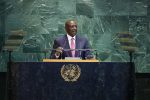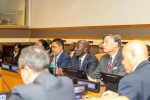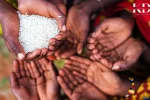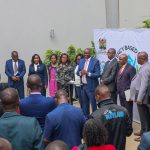Tears of joy welled in Evans Mogambi Moseti’s eyes as he tentatively turned the tap in his new apartment in Mukuru kwa Njenga, allocated just ahead of the official handover.
One of the 1,080 beneficiaries of the Mukuru Social Housing Project, Moseti could hardly believe the transformation.
“This is real,” he murmured, a wave of disbelief washing over him. “The water is clean and fresh. This is a surprise, a true surprise.”
For years in Mukuru Riara, flowing water had been a distant dream. An unimaginable luxury. Now, it was here, in his own hands.
Thousands of families in Mukuru kwa Njenga are set to gain more than just new homes; they are stepping into a future of dignity, opportunity, and improved quality of life.
From safe and modern housing to access to schools, clinics, clean water, and job opportunities, the Mukuru Affordable Housing Project promises a complete lifestyle transformation for Nairobi’s low-income earners.
The housing development, now in its final stages, is part of the Government of Kenya’s nationwide initiative to bridge the housing gap by constructing 250,000 units annually.
The Mukuru Social Housing Project targets residents of surrounding informal settlements with the goal of upgrading housing in slums and replacing them with structured, service-rich communities.
The 56-acre project at the Meteorological Site in Nairobi County, popularly known as Met Site, will ultimately offer 13,264 housing units.
According to the Affordable Housing Board, the project has been designed as a mixed-use development to cater to Kenyans across income brackets.
“It is a mixed-type of development whereby we have social units for those earning Sh20,000 and below, affordable units for those between Sh20,000 and Sh149,000, and some units targeted for upper-middle-income earners making above S 149,000,” said Mary Kamau, who works in the real estate department at the board.
Pastor Evans Mogambi Moseti during the verification and allocation exercise of the affordable housing units.
The first phase, five blocks totaling 1,080 units, is 99 percent complete and is due to be handed over by President William Ruto after final government inspection.
“For the past week,” Mary says, “we have been on site allocating the first lot of social units, which are studio apartments. These have been earmarked for residents from the informal settlements of Mukuru and Mariguini.”
She adds that an enumeration exercise was conducted, followed by registration, verification and allocation.
Construction of additional phases is ongoing, with several buildings already at the roof terrace level and others at the seventh floor. Residents moving into Mukuru will benefit from far more than brick-and-mortar.
The development features vital amenities including a primary school with a kitchen and dining hall, three daycare centres, an administration block, a police station, fire station, outpatient clinic, shopping mall and six boreholes.
There will also be garbage collection points, 39 transformer power rooms and a power substation.
Green spaces, a network of 3.2 kilometres of roads and drainage systems and 780 parking slots have also been factored into the plan, ensuring the estate is livable and sustainable.
To make the homes accessible, the government is offering them through a Tenant Purchase Scheme (TPS) at a monthly rate of Sh3,800, targeting low-income earners who otherwise would not otherwise afford dignified housing.
The social and economic impact of the project is already being felt as more than 4,000 people have been employed directly and indirectly, including engineers, masons, electricians, painters and service staff.
For many families, the Mukuru kwa Njenga Affordable Housing Project marks the beginning of a new chapter one where they can raise their children in a secure, healthy environment, access essential services and build a future in a community designed with their needs in mind.









